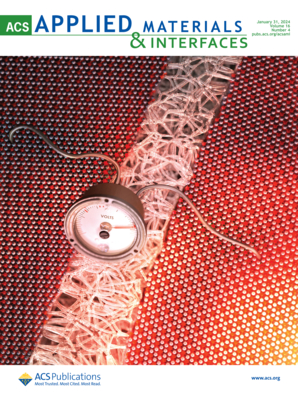IF 8.3
2区 材料科学
Q1 MATERIALS SCIENCE, MULTIDISCIPLINARY
引用次数: 0
摘要
全球含油废水污染日益严重。传统的处理方法往往因效率低下和二次污染而失败。因此,开发先进的膜分离技术至关重要。虽然膜分离技术有望成为一种解决方案,但其广泛应用必须克服与耐腐蚀性、耐碱性和防止膜堵塞有关的重大障碍。本研究采用生物启发的纳米多孔金属有机框架改性玄武岩纤维织物(BFF),提出了一种新型高效的油水分离方法。UiO-66-NH2 因其高孔隙率和可调功能性而闻名,它与 BFF 上的壳聚糖-多巴胺(CS-DA)层相结合,创造出一种具有增强亲水性和水下超疏水性的多功能膜。这种生物启发设计(指模仿自然结构或机制以提高性能和效率的工程解决方案)从天然材料的结构和功能中汲取灵感,实现了卓越的油水分离性能,显示出出色的通量和油排斥率。UiO-66-NH2 的高孔隙率可有效捕捉油滴,而 CS-DA 层则有利于水的渗透并提高表面稳定性。此外,这种复合膜还具有优异的稳定性和可重复使用性,因此有望成为高效、可持续油水分离应用的候选材料。这项研究展示了生物启发设计原理在开发创新解决方案以应对紧迫环境挑战方面的潜力。本文章由计算机程序翻译,如有差异,请以英文原文为准。

Bioinspired Nanoporous MOF-Modified Basalt Fiber Fabrics for Efficient and Multifunctional Oil–Water Separation
Oily wastewater pollution is increasing globally. Conventional treatment methods often fail due to inefficiency and secondary contamination. Therefore, developing advanced membrane separation technologies is crucial. While membrane separation technology holds promise as a solution, its widespread applicability necessitates overcoming significant obstacles related to corrosion resistance, alkali resistance, and the prevention of membrane fouling. This study presents a novel and highly efficient approach for oil–water separation, employing bioinspired, nanoporous metal–organic framework-modified basalt fiber fabrics (BFF). The integration of UiO-66-NH2, renowned for its high porosity and tunable functionalities, with a chitosan-dopamine (CS-DA) layer on BFFs creates a multifunctional membrane with enhanced hydrophilicity and underwater superoleophobicity. This bioinspired design (refers to engineering solutions that mimic natural structures or mechanisms to improve performance and efficiency), drawing inspiration from the structure and function of natural materials, results in superior oil–water separation performance, demonstrating excellent flux and oil rejection rates. The UiO-66-NH2 effectively captures oil droplets due to its high porosity, while the CS-DA layer facilitates water permeability and promotes surface stability. Furthermore, the composite membrane exhibits exceptional stability and reusability, positioning it as a promising candidate for efficient and sustainable oil–water separation applications. This research showcases the potential of bioinspired design principles for developing innovative solutions to pressing environmental challenges.
求助全文
通过发布文献求助,成功后即可免费获取论文全文。
去求助
来源期刊

ACS Applied Materials & Interfaces
工程技术-材料科学:综合
CiteScore
16.00
自引率
6.30%
发文量
4978
审稿时长
1.8 months
期刊介绍:
ACS Applied Materials & Interfaces is a leading interdisciplinary journal that brings together chemists, engineers, physicists, and biologists to explore the development and utilization of newly-discovered materials and interfacial processes for specific applications. Our journal has experienced remarkable growth since its establishment in 2009, both in terms of the number of articles published and the impact of the research showcased. We are proud to foster a truly global community, with the majority of published articles originating from outside the United States, reflecting the rapid growth of applied research worldwide.
 求助内容:
求助内容: 应助结果提醒方式:
应助结果提醒方式:


